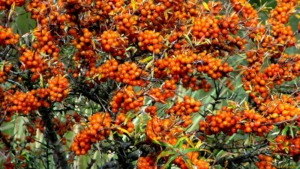Sea buckthorn (Hippophae rhamnoides L.) is well known all over for its valuable berries. Nevertheless, presently not only berries, but also leaves contain nutritionally beneficial hydrophilic and lipophilic compounds. Additionally, It was reported that not only leaves, but also other vegetative parts, e.g. shoots, may be used as a valuable source of phenolic compounds. Those bio-compounds, especially tocopherols and tocotrienols, are reported to possess a wide spectrum of biological activities, such as antioxidant and inflammatory properties.
Five lipophilic compounds, including α tocopherol homologues (α-T), β tocopherol homologue (β-T) and γ tocopherol homologue (γ-T), plastochromanol-8(PC-8) and β-carotene, were identified in each vegetative part of sea buckthorn (leaves, shoots, berries and buds) male and female plants.
In addition, significant amounts of α-T3 (1.99 mg/100 g dw) were detected in buds. In each vegetative part of both male and female sea buckthorn plants α-T was a predominant homologue of tocopherol (81.9–96.9%).
 However, when the concentration of α-T was considered in relation to all identified lipophilic antioxidants, it accounted for 57.6–74.0% and 39.2–65.0% in vegetative parts of female and male plants, respectively. The smaller percentage of α-T in parts collected from male plants is due to a higher concentration of β-carotene and lower of α-T when compared to those collected from female plants.
However, when the concentration of α-T was considered in relation to all identified lipophilic antioxidants, it accounted for 57.6–74.0% and 39.2–65.0% in vegetative parts of female and male plants, respectively. The smaller percentage of α-T in parts collected from male plants is due to a higher concentration of β-carotene and lower of α-T when compared to those collected from female plants.
By contrast, in most of the fruit seeds and kernels γ-T is a predominant homologue with some exceptions, for example Chaenomeles japonica, in which, similarly as in leaves, α-T is the predominant form of tocopherol. β-Carotene accounts for 19.4–33.1% and 29.5–46.3% of total identified lipophilic antioxidants in vegetative parts of female and male sea buckthorn plants, respectively.
The contribution of β-T, γ-T and PC-8 was within a similar range of 0.7–4.0% in all vegetative parts of sea buckthorn, with the exception of γ-T (6.8%) and α-T3 (10.8%) in buds. Significant differences (p < 0.05) were detected between analysed lipophilic compounds in various sea buckthorn parts. The highest concentration of α-T was detected in female leaves, while it was lowest in buds (35.41 and 7.25 mg/100 g dw, respectively). Approximately a twofold lower amount of α-T was recorded in shoots and berries of female and shoots of male plants when compared with their counterparts in leaves.
However, the concentration of α-T in shoots of female plants was almost twofold higher than in shoots of male plants (19.56 and 10.87 mg/100 g dw, respectively). The concentration of α-T in the present study is slightly lower when compared to the previous study; though, vegetative parts of sea buckthorn were collected two weeks earlier and as it was shown previously, the amount of α-T increases during leaf development.
Nevertheless, the trend towards a higher concentration of α-T in leaves of female plants than male plants has been maintained in both studies. The highest concentration of β-carotene was recorded in leaves of male and female plants (24.57 and 20.33 mg/100 g dw, respectively).
These data are comparable with the previous study. A significant concentration of β-carotene in sea buckthorn leaves was also reported. Much lower levels of β-carotene when compared to leaves (3–4 times) were recorded in the other vegetative parts of sea buckthorn. Differences in the concentration of β-carotene in shoots of female and buds of male as well as in berries of female and shoots of male plants were not statistically significant (6.46 and 7.23, and 4.43 and 4.94 mg/100 g dw, respectively). The highest concentrations of β-T, γ-T and PC-8 were detected in leaves, especially from female plants (2.43, 1.51 and 1.79 mg/100 g dw, respectively), while they were lowest in shoots of plants of both sexes (0.21–0.22, 0.41–0.44 and 0.19–0.26 mg/100 g dw, respectively). When studying tocopherols, tocotrienols and carotenoids in sea buckthorn berries during ripening higher amounts of tocopherols and β-carotene were found when compared to the present study; however, the harvesting time was markedly later (end of July and the middle of June, respectively). To the best of our knowledge this is the first report on the lipophilic antioxidant composition in sea buckthorn shoots and buds, therefore, a direct comparison is difficult.
Sea buckthorn leaves and shoots have a great potential in food processing due to the biologically active substances; therefore, at the beginning of their development, when shoots are still green, tender and non-woody, it seems to be a valuable source of lipophilic antioxidants. The presented study confirms this statement, proving that not only leaves of sea buckthorn, but also its shoots are a good source of α-T.
The presented study shows that α-T and β-carotene are predominant lipophilic antioxidants, accounting for 78.3–97.0% of identified compounds in different parts of sea buckthorn (H. rhamnoides L.) plants. A significant effect on concentrations of α-T and β-carotene was found not only for the vegetative part, but also plant sex. Leaves of female plants were richest in lipophilic antioxidants. The information concerning lipophilic antioxidants, which play a significant role in protection against oxidative stress, should improve the nutritional value of sea buckthorn vegetative parts and promote their use in food and pharmaceutical industries.

Leave A Comment